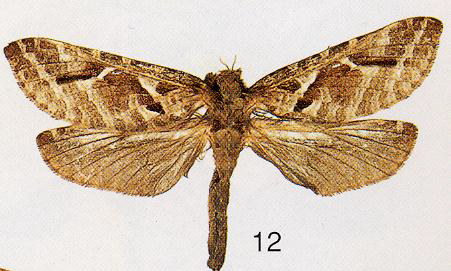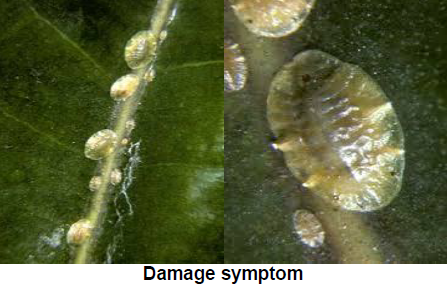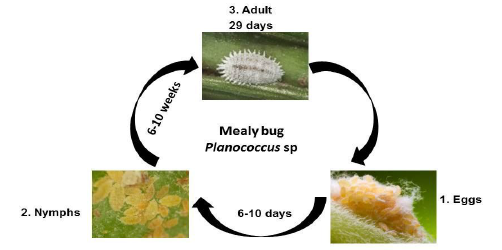Clove Insect pests
Clove Insect pests
Stem borer
Biology:
- Egg: The eggs are laid on the weeds around the basins of clove trees.
- Larva: Early instar larvae feed on the weed plants and the later instars mig
 rate to the clove trees and bore into the stem. The larvae are creamy white with a black head and fully grown larvae measure about 90 mm in length. The dorsal sclerites of the thoracic and abdominal segments are brown.
rate to the clove trees and bore into the stem. The larvae are creamy white with a black head and fully grown larvae measure about 90 mm in length. The dorsal sclerites of the thoracic and abdominal segments are brown. - Pupa: Pupation occurs within the larval tunnel.
- Adult: The adult is a large sized moth with a wing span of about 110 mm with greyish brown mottled forewings.
Damage symptoms:
- The larva of the stem borer girdles the stem of young clove trees at the basal region and bores downward into the root zone.
- The girdled region and the bore-hole are covered with frass consisting of coarse wood particles that are formed as a mat-like structure.
- The infested trees wilt and defoliate and succumb to the pest attack subsequently.
Natural enemies of Stem borer: Predators: Bird: Wood-pecker
Scale insects
Many species of scale insects infest clove seedlings in the nursery and sometimes young plants in the field.
Black Scale: Paraaissetia nigra
Identification of pest: Female adults are elliptical, flattened and shiny black.
Damage symptoms
- It infests tender leaves, shoots and twigs.
- Sooty mould fungus is observed on leaves due to honey dew secretion.
Masked scale: Mycetaspis personata
Identification of pest: Female adults are elliptical, flattened and black in colour.
- Egg: Eggs are laid under or stay within the female body then hatch to produce nymphs or crawlers. Some species give birth to live young.
- Nymph: First instar nymph is highly mobile. Later instars less so.
- Adult: The mature female is sedentary, headless, legless and wingless and attaches herself to the plant by her mouthparts (stylet) and forms a waxy, leathery or cottony covering over her soft body. They can produce more than 150 eggs then die.
In some species fertilisation is not required and males have not been found. The males of other species live under their protective covering until mature then emerged as winged adults. They tend to live in colonies. They may be tended by ants who feed on the honey dew and protect them from predation.
Damage symptoms
- Dome shaped and greyish brown scale will be seen on the under surface of leaves especially of young clove plants.
- The infested leaves become discoloured and completely yellowish and finally may fall down. Green scale
- Egg: Vary in size and color but are generally oval in shape.
- Nymph: Nymphs are yellow "crawlers" migrate to the leaves and settle on the undersides along the midrib and veins.
- Adult: Females vary in size and colour but are generally oval in shape
Damage symptoms:
- Flat and green coloured soft scales are found feeding on leaves and tender shoots.
- Infestation of scales is on leaves and tender shoots, and is serious in the nursery. Young seedlings if attacked are killed soon.

Natural enemies of scale insect:
- Parasitoids: Encarsia sp, Aphytis sp and Comperiella sp
- Predators: Coccinellid and Pharoscymnus flexibilis
Mealy bug
Biology:
- Eggs: Eggs are deposited as white cottony masses called ovisacs on trunk and stems of plants, giving the appearance of cotton spread on plants. The glossy, light yellow eggs are oval and approximately 0.3 mm long. A female can lay from 300 to 600 eggs in her life period, which are deposited in groups of 5 to 20. Depending on the season, egg hatch may occur after 6 - 10 days or several weeks. An average of 29 eggs per day is laid by females.
- Nymphs: Nymphs emerge from the ovisacs and typically settle along midribs and veins on the underside of leaves, young twigs, and fruit buttons. Wax and honeydew secreted by crawlers are visible indicators of infestations. First instar female and male nymphs are called crawlers. The nymphs take 6 to 10 weeks to reach maturity. The nymphs are yellow, oval-shaped with red eyes, and covered with white waxy particles The female nymphs resemble the adult female in appearance, while male nymphs are more elongated. Female nymphs have four instars while males have three instars.
- Adult: Adult size ranges in length from 3 mm (females) to 4.5 mm (males). The females are wingless, white to light brown in color, with brown legs and antennae. The body of adult females is coated with white wax and bears a characteristic faint gray stripe along their dorsal side. Short waxy filaments can be seen around the margins of their oval body with a slightly longer pair of filaments present at the rear end of their body. Female mealybugs are wingless and, therefore, must be transported to subsequent host plants, although they are able to crawl for short distances. Females can live for up to 29 days depending on the host plant. Males are similar in color to females and have two long backward-projecting white wax threads.
Life cycle

Damage symptoms:
- Damages due to mealy bugs occur by sucking the sap from tender shoots. Affected portions dry up gradually.
- Soft green mealy bug with a white mealy ovisac is seen on the undersurface of tender leaves.
- The feeding causes yellowing and withering of leaves.
- Sooty mold develops on the honey dew secreted by the bug.
Natural enemies of mealy bug:
- Parasitoids: Parasitic wasps,Leptomastix dactylopii
- Predators: Hover flies, Chrysoperla, ladybugs or mealy bug destroyers (Cryptolaemus montrouzieri)
IPM for Clove
To know the IPM practices for Clove, click here.
Source: NIPHM and Directorate of Plant Protection, Quarantine & Storage
Last Modified : 3/30/2020
This topic covers information about Walnut Insect...
This topic covers information about Fig insect pe...
This topic provides information about Cherry- Inse...
This topic covers information about Description of...
